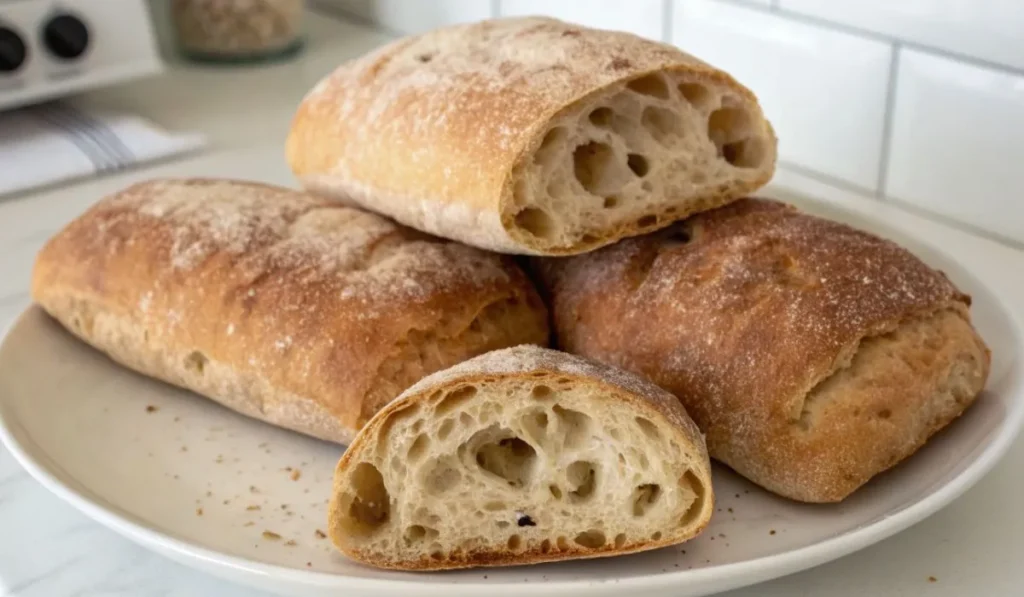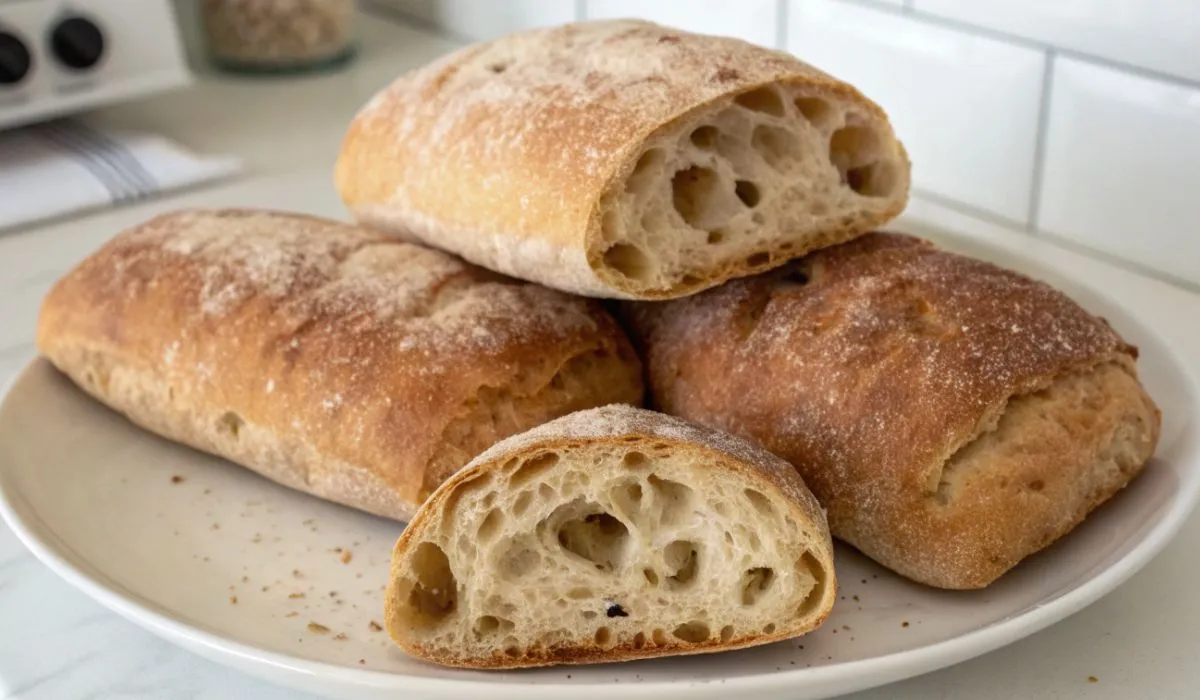Making authentic ciabatta bread recipe at home creates that perfect crusty exterior and airy interior you love from Italian bakeries.
This rustic bread needs just four simple ingredients and delivers amazing results.
After baking dozens of loaves in my kitchen, I’ve perfected this foolproof method that works every time.

Essential Ingredients for Perfect Ciabatta
The beauty of homemade ciabatta lies in its simplicity. Here’s what you need:
- Bread flour – Creates the chewy texture that makes ciabatta special
- Active dry yeast – Powers the fermentation process
- Water – Two different temperatures for the preferment and dough
- Salt – Essential for flavor development
- Olive oil – Helps handle the sticky dough
I always use bread flour instead of all-purpose flour. The higher protein content gives you that signature chewy crumb with beautiful air pockets.
Two-Day Process Made Simple
This Italian bread recipe requires patience but minimal active work. Here’s the timeline:
1. Day One:
- Mix the preferment (biga) in 5 minutes
- Let it ferment for 8-24 hours at room temperature
2. Day Two:
- Make the main dough
- Complete four stretch-and-fold cycles
- Shape and proof the bread
- Bake with steam for crispy crust
The preferment step creates complex flavors that you can’t achieve with a same-day recipe.
I learned this technique from Italian bakers who taught me that time is the secret ingredient.
Master the Stretch and Fold Technique
Working with high-hydration dough feels intimidating at first. Here’s how to handle it:
- Oil your hands and spatula to prevent sticking
- Visualize a clock on your dough surface
- Lift at 12 o’clock and fold to 6 o’clock
- Turn bowl 90 degrees and repeat
- Complete 8 total folds per session
- Rest 30 minutes between each session
This gentle technique builds gluten strength without overworking the dough. I remember my first attempts were messy, but practice makes perfect.
Shaping Your Ciabatta Loaves
Turning sticky dough into beautiful bread shapes requires the right approach:
- Flour your work surface generously
- Use a bench scraper as your best friend
- Gently pat dough into a 10×7 inch rectangle
- Cut into 8 rolls or 2 large loaves
- Transfer carefully to parchment paper
- Don’t worry about perfect shapes – rustic looks authentic
The key is being gentle. Rough handling deflates all those precious air bubbles you’ve worked to create.
Creating Steam for Crispy Crust
Professional ovens have steam injection, but home bakers can create similar results:
- Preheat a baking sheet for one hour
- Prepare a pan with ice cubes
- Spray bread lightly with water before baking
- Work quickly to trap steam inside oven
- Bake at 450°F for 20-25 minutes
Steam keeps the crust flexible during the first part of baking, allowing maximum expansion. Then it evaporates, leaving that golden, crispy exterior.
Troubleshooting Common Issues
Every baker faces challenges with this artisan bread. Here are solutions:
Dense, heavy bread:
- Check yeast expiration date
- Ensure water temperature is correct
- Don’t add too much flour during shaping
Flat, spreading loaves:
- Complete all stretch-and-fold sessions
- Don’t skip the refrigeration step
- Handle gently during final shaping
Gummy interior:
- Cool completely before slicing (45 minutes minimum)
- Check internal temperature reaches 205°F
- Avoid cutting too early
I’ve made every mistake possible, so learn from my experience!
Storage and Serving Tips
Fresh ciabatta tastes best within 24 hours. Here’s how to maximize enjoyment:
- Store loosely covered at room temperature
- Reheat in 350°F oven for 5 minutes to restore crispness
- Slice horizontally for sandwiches
- Use day-old bread for crostini or croutons
- Freeze baked loaves up to 3 months
My family loves these rolls for Italian sandwiches, especially with fresh mozzarella and tomatoes.
Recipe Variations to Try
Once you master the basic technique, experiment with these additions:
- Rosemary and garlic – Add 2 teaspoons fresh rosemary and 2 minced cloves
- Olive ciabatta – Fold in 1/2 cup chopped olives after final stretch
- Whole wheat version – Replace 1/2 cup bread flour with whole wheat
- Herb-crusted – Sprinkle dried herbs on top before baking
Each variation brings new flavors while maintaining that classic ciabatta texture.
Final Tips for Success
After years of bread making, these details matter most:
- Weigh ingredients for consistent results
- Don’t rush the fermentation process
- Keep dough as wet as you can handle
- Practice makes perfect – don’t give up
- Temperature and humidity affect timing
This authentic ciabatta recipe transforms simple ingredients into bakery-quality bread. The process takes time, but the results justify every minute.
Start your preferment tonight, and tomorrow you’ll have fresh Italian bread that rivals any restaurant.

Easy Homemade Ciabatta Bread
Ingredients
Equipment
Method
- Day 1 – Make the Biga: In a large mixing bowl, whisk together 1 cup bread flour and 1/8 teaspoon yeast. Add 1/2 cup room temperature water and mix with a silicone spatula until combined. Cover tightly with plastic wrap and let rest at room temperature for 8-24 hours.
- Day 2 – Make the Dough: In a separate large bowl, whisk together 1 teaspoon yeast and 1 cup warm water. Let sit 5-10 minutes until yeast dissolves. Add the fermented biga, 2 1/2 cups flour, and salt. Mix with a spatula until uniform and sticky. The dough will be very wet – this is normal.
- First Rest: Cover the bowl and let dough rest for 30 minutes at room temperature.
- Stretch and Fold #1: Oil your hands or spatula. Lift the dough at 12 o’clock and fold it over to 6 o’clock. Turn bowl 90 degrees and repeat. Continue until you’ve made 8 total folds around the bowl. Cover and rest 30 minutes.
- Stretch and Folds #2-4: Repeat the stretch and fold process three more times, resting 30 minutes between each session. After the 4th stretch and fold, cover and refrigerate for at least 1 hour and up to 24 hours.
- Shape the Rolls: Generously flour your work surface. Using oiled hands, gently scrape dough onto floured surface. Sprinkle flour on top and gently pat into a 10×7 inch rectangle. Cut into 8 equal pieces using a floured bench scraper.
- Transfer and Final Proof: Line parchment paper with flour. Carefully transfer dough pieces to parchment, spacing 2 inches apart. Dust tops with flour and cover with a clean towel. Let rest 1 hour at room temperature.
- Preheat Oven: Place a baking sheet on the center rack and preheat oven to 450°F for 1 hour. Position another rack at the bottom for the steam pan.
- Create Steam and Bake: Fill a metal roasting pan with ice cubes. Uncover rolls and lightly spray with water. Quickly slide parchment with rolls onto the preheated baking sheet. Place ice pan on bottom rack and close oven door immediately to trap steam.
- Bake: Bake for 20-25 minutes until golden brown and hollow-sounding when tapped. Internal temperature should reach 205-210°F. Cool on a wire rack for at least 45 minutes before slicing to prevent gummy texture.
